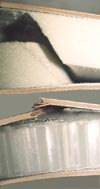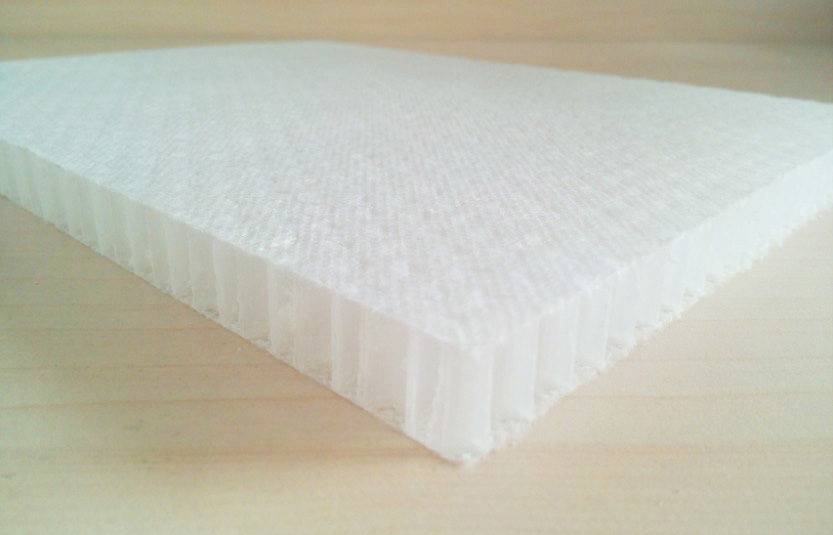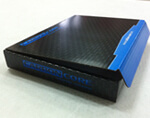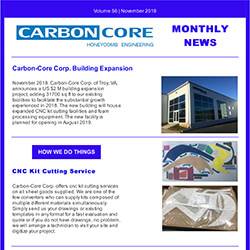CarbonCore’s line of lightweight plastic honeycomb core material doesn’t just look good on the lab charts.
They stand up to the tests of the real world. In laboratories, the results can be controlled by highly skilled lab technicians, but when you are out in your boat on the water you need resilience to bumps and grinds. Building with CarbonCore plastic honeycomb assures you that your boat is built with a lightweight, durable, plastic honeycomb and is ready to handle all kinds of stresses. CarbonCore’s Plastic Honeycomb is a core material with unique properties that combines the strength and resilience of our special Honeycomb sheet design, while also remaining a great sound damping material with excellent structure-born sound damping properties.
Content not available for mobile phone.
Please view Flash videos on laptop or PC.

Nature provides the geometry, we provide the honeycomb composite material. CarbonCore plastic honeycomb is extruded from tough, versatile polypropylene plastic. Thermo fused to the honeycomb cells are non-woven polyester bonding scrims with a polypropylene barrier film to limit resin consumption. CarbonCore plastic honeycomb is ideal for Marine applications and is recognized by the US Coast Guard as a primary flotation material in small boats when encapsulated in a laminate material.

The important question is: “How do these plastic honeycomb sheets hold up in the real world?” Although no lightweight sheet is the answer to every possible application, CarbonCore boasts the broadest list of positive features. Some honeycomb cores are either stiff, light, quiet or economical. CarbonCore is all of the above…and more!

Polypropylene honeycomb is an effective sound dampening material that provides a very low natural harmonic due to the polypropylene’s viscoelacity and cell structure, effectively dampening sound and vibrations. Boats manufactured with CarbonCore Plastic Honeycomb sheets demonstrate a dramatic improvement in vibrational dampening compared to traditional lightweight sheet construction methods.
Acoustics
1. – INTRODUCTION
The CarbonCore honeycombs have high acoustical characteristics because of their composition :
Damping Properties
- They are made of polypropylene, a viscoelastic material, ready to absorb vibrations.
Sound Absorption Properties
- The mesh of the honeycombs structure, with its particular shape, allows to trap and damp most of the sound waves. In reality, the sound gets inside the cells, then rebounds decreasingly on the cell walls (because of their viscoelastic properties)
Sound Insulation Properties
- Made with the accurate facings, the CarbonCore honeycombs (whose cells contain air) make the “spring” part of a composite system mass/spring/mass, working efficiently against the sound transmission.
2. – VIBRATION DAMPING
The damping properties of a material are its capacity to reduce the vibrations under which it is submitted. Theses vibrations could have mechanical or acoustical origins. A material has good damping properties if it releases low vibration levels, consequently if it has a low acoustical radiation. At the opposite, a poor damping material will vibrate at the lowest stimulation applied to it.
The damping capacity is characterized by the loss factor h, with values generally between 0 and 1. The Young modulus of the material has also an influence on this factor. To reach a high damping level, you need a soft material, capable to transform into heat all vibrations. It is true for the viscoelastic polymers, and especially for polypropylene. Consequently, the CarbonCore honeycombs are well adapted for all the applications where the sound level of a vibrating structure has to be lowered.
For your information, the following curve is comparing the damping level resulting from different panels. The vibrations are made by a motor boat. The X line shows the motor rotation speed, and on the Y line the vibration level.
The CarbonCore efficiency can easily be noticed on the above graphics because it is a viscoelastic product with a low modulus. Compared with a wooden core, it is possible in some case to lower by 50% the vibrations level.
3. – SOUND ABSORPTION
The acoustic absorption is the property which prevents sound reflection. To have a good absorption level, you need a material which is able to trap the sound waves. It is true for the porous or honeycombs materials on which the sound wave spreading is limited. The acoustical absorption is characterized by the “a sabine” factor. This factor is between 0 and 1. It is higher as the absorption level is increasing.
To have an efficient absorption level, the CarbonCore has to be covered on one side with an air porous facing.
The sound waves get inside the cells and then are trapped like in an Helmoltz resonator: they rebound inside on the walls until they are completely absorbed.
Below find the two separate and informative graphics on the a value for two different types of CarbonCore sandwich panels:
We notice a large absorption level for most of the frequencies. However, it is possible to shift the absorption level and the graph top value by playing on the CarbonCore thickness and on the facing porosity.
4. – SOUND INSULATION
The acoustic properties for an element dividing two rooms are defined by its ability to lower the noise released from one side and its perception on the other side. The insulation is characterized by the weaken factor quoted R (the difference between the released and received intensities) which may shift from a few decibels to several ten decibels (for information, the decibels are calculated from a logarithmic scale. A 3dB decrease represents a decrease of half of the sound power).
It is important to differentiate two types of partition for the acoustic insulation analysis:
- If we consider a structure with a single homogenous partition, the only factor which increases sound insulation is the mass. Heavier is the partition and better is the insulation.
- If we consider a composite structure (mass/spring/mass), which means an alternation of heavy layers and damping layers, it is then more difficult to define the weaken value factor.
To simplify, in such a structure, the first “mass” vibrates and transmits the waves to the “spring”. This “spring” then transmits the vibrations to the second “mass”, but because of its composition, it damps them. Such a structure has a resonance frequency where its weaken factor is low, but by playing on the mass for the partitions, it is possible to “choose” this resonance frequency. For example, we can look for it, to bring out the structure resonance frequency under 90 Hz which is the lower limit of the defined spectrum for the acoustic in the building. The weaken value for a composite structure, as soon as we are above the resonance frequency, is in all cases above and very above the value obtained with the heavy mass alone. - The CarbonCore honeycombs allow making light structural sandwich panels. In these composite panels, they will play like a spring as related above. The facings of the sandwich panels are the heavy mass of the structure. Thus, it is possible to have a very good weaken factor for the sandwich structure made with a CarbonCore core.
- Compared to glass wool, CarbonCore® will not reach the same damping levels. However, it makes a compromise between sound damping and structural properties, which other insulation materials are not able to compete against.
- The acoustical properties for sandwich panels made with CarbonCore are bond to a lot of parameters (the facing types which cover the CarbonCore core, the sizes, fixation types, the acoustical waves and frequencies applied…). It is not possible to give all the main characteristics, but only indicative values with different facings and under various acoustical solicitations:
Below, some acoustical insulation graphics for CarbonCore – based sandwich panels with two different facings:
NOTE: The indicated directions can serve as a guide to use the product but cannot be considered as a guarantee of a good working up. Additionally, application, utilization and/or transformation of the products escape our control possibilities. As a consequence, they exclusively remain the responsibility of the user and/or the transformer.

Plastic Honeycomb(scored)
Engineering
The mechanical properties of CarbonCore Honeycomb sheet core material are controlled by the following specifications:
- Physical properties of the thermoplastic
- Cell diameter
- Wall gauge (thickness of the cell wall)
- Core thickness
- Facings applied to the core.
Altering one or more of these specifications will produce different performance characteristics. CarbonCore plastic honeycomb sheets can be engineered to be a specific weight, absorb a specific load, rebound at a specified rate and possess the flexibility or stiffness required by the end application.

No catastrophic failure mode
Rot Proof
PVC and SAN Foams are attacked by styrene and absorb water when exposed, plywood and balsa wood rot or lose strength when wet. Carbon-Core plastic honeycomb does NOT rot and is unaffected by most solvents and chemical agents. Additionally, when encapsulated in a laminate using a non-aqueous resin, the scrim forms a seal limiting water migration through the structure, even if skin is punctured.
Excellent Bond As A Structural Material
The honeycomb cell walls are fused into the non-woven polyester scrim. That coupled with the scrim’s affinity for virtually any resin or adhesive system provides exceptional bond and peel strength.
Impact Resistant Core Material
There are many cores that can make a light, stiff structure. CarbonCore, however, combines the light weight and stiffness of honeycomb with tough polypropylene plus superior bonding properties due to the thermo fused scrim. The combination allows CarbonCore plastic honeycomb sheets to absorb and dissipate impacts and shocks repeatedly that would cause ultimate catastrophic failure in other core materials.
Thermal Insulation Of Core Material
CarbonCore plastic honeycomb sheets have the ability to dissipate heat from the bondline, which prevents heat from accumulating either in the cells of the plastic honeycomb core or in the critical skin laminate so heat deflection temperatures are not exceeded. While the combination of polypropylene cell walls and dead air space provides insulation properties, there is some radiational transfer through the plastic honeycomb cell that prevents heat banking at the bondline. If greater thermal insulation is required we can provide foam filled honeycomb sheets.
Recyclable
Carbon-Core’s plastic honeycomb architectural panels are 100% recyclable, making it the choice material for automotive application. Available with a wide variety of facings, from polypropylene carpet to patterned skins, entire sections can be recycled as a whole. Carbon-Core honeycomb sheets are thermo-formable, thus cutting production cost to level acceptable to large OEM manufacturers.
Corrosion Resistant
Always a concern for automotive industry, Carbon-Core, with its corrosion resistance, low water absorption, and high strength advantages, is also a suitable choice for oil drilling platform construction, double containment vessels, tank bottoms and lids, duct work, and wherever corrosion is a problem and chemical resistance is a must.
Click on a picture to enlarge it.




